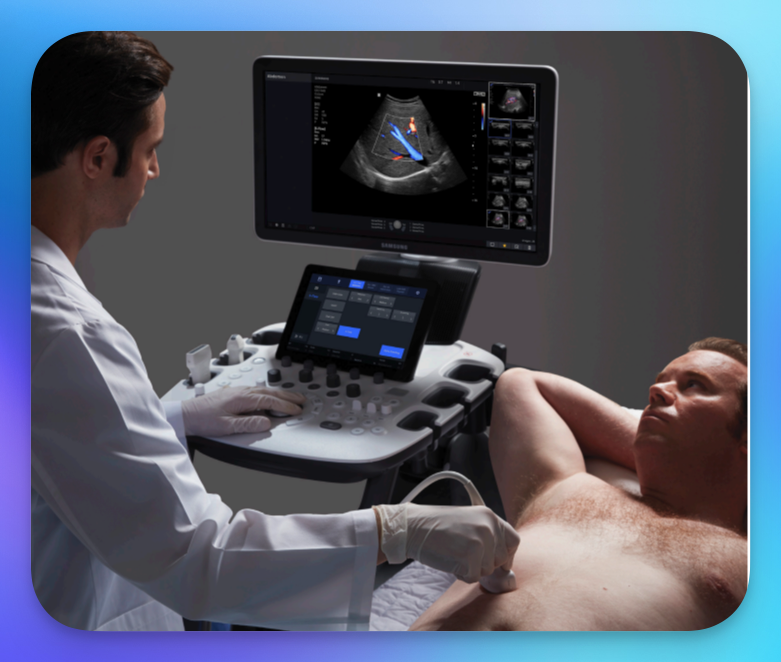What is an Abdominal Ultrasound?
Abdominal ultrasound is a non-invasive medical examination that uses high-frequency sound waves to display internal organs and structures in the abdominal cavity. The examination allows doctors to assess organs such as the liver, gallbladder, pancreas, kidneys, spleen, and blood vessels. Abdominal ultrasound is popular due to its safety, as it does not use ionizing radiation, unlike X-rays. More about ultrasound can be read on Wikipedia, where the functioning of this method is explained in more detail.
When is Abdominal Ultrasound Recommended?
Abdominal ultrasound is recommended when a doctor suspects problems with digestive organs or wants to monitor the condition of a specific organ. For example, it is often used to detect gallstones, cysts, tumors, liver inflammation (hepatitis), abdominal cavity injuries, or kidney stones. It is also used to assess blood flow through abdominal blood vessels, which is particularly useful in diagnosing abdominal aortic aneurysm. A more detailed list of indications for ultrasound examinations is available at Mayo Clinic.
Preparation for the Procedure
Preparation for abdominal ultrasound is simple, but requires certain steps to ensure accurate results. Most patients must fast for at least 6 to 8 hours before the examination. This means that before the examination, you should not consume food or drinks, except water, as gases in the digestive system can hinder organ examination. If only the kidneys are being examined, it is recommended to drink a larger amount of water to fill the bladder, which allows for a better examination. Healthline provides additional information about preparation for abdominal ultrasound.
What to Expect During the Examination
The abdominal ultrasound procedure itself is simple and painless. The patient usually lies on their back, and a gel that improves the conductivity of sound waves is applied to the abdomen. A doctor or specialist then examines different parts of the abdomen with an ultrasound probe, while the device creates images of internal organs in real time. The ultrasound examination usually takes between 30 and 60 minutes, depending on the complexity of the case. There are no special restrictions after the examination, so you can continue with your daily activities. More about sami tehniki preiskave can be read on Radiopaedia.

Interpretation of Results
Po končanem ultrasound specialist pregleda slike in pripravi poročilo za vašega zdravnika. Results may show various conditions, such as organ enlargement, presence of stones, cysts, tumors, or abnormalities in blood flow. Although ultrasound provides a comprehensive examination, additional tests such as CT or MRI are sometimes needed to confirm the diagnosis. Mayo Clinic describes various scenarios when these additional examinations are necessary.
Advantages and Risks
Advantages of Abdominal Ultrasound include its non-invasiveness and absence of radiation. Since it does not use ionizing radiation, as X-rays do, it is a safe choice even for pregnant women. The procedure is quickly performed, without complicated preparations, and enables reliable diagnosis of problems such as gallstones or kidney stones. However, there are certain limitations; the presence of gases in the intestines can affect the quality of images, which may require additional examinations. Information about the safety of the procedure can be found at Radiopaedia.
Frequently Asked Questions
Is abdominal ultrasound painful? No, the procedure is completely painless. You may only feel a slight pressure as the probe moves across the abdomen, but this is usually not uncomfortable.
How long does an abdominal ultrasound take? Postopek običajno traja od 15 do 45 minut, odvisno od specifičnega namena pregleda.
Do I need to fast before the examination? Yes, most patients must fast for at least 6 to 8 hours before the examination to reduce the presence of gases in the digestive system and allow for a clearer examination.
What can an abdominal ultrasound detect? The examination can detect various conditions such as gallstones, cysts, tumors, liver inflammation or kidney stones, and abnormalities in blood flow through abdominal vessels.
Can I take medications before the examination? Yes, you can usually take your medications with a small amount of water, but consult your doctor about this.
Don't Delay Your Examination
Abdominal ultrasound is one of the most popular and safe methods for assessing the health of abdominal organs. Due to its non-invasiveness and ability to provide accurate information, it is a key diagnostic tool in modern medicine. If you have any symptoms such as abdominal pain, digestive problems, or unusual changes in organ function, consult your doctor and consider an ultrasound examination.
Kako se naročim na ultrazvok v Ultrazdravju?
You can schedule an examination:
✅ Online on our page /narocanje or by clicking the button "Book an Appointment" below.
✅ By phone 01 777 4255 for fast scheduling without waiting lists.
✅ Via social networks – Facebook messenger, Instagram, Telegram... Click on the blue icon in the bottom right.
👉 Don't delay, schedule today and take care of your health!